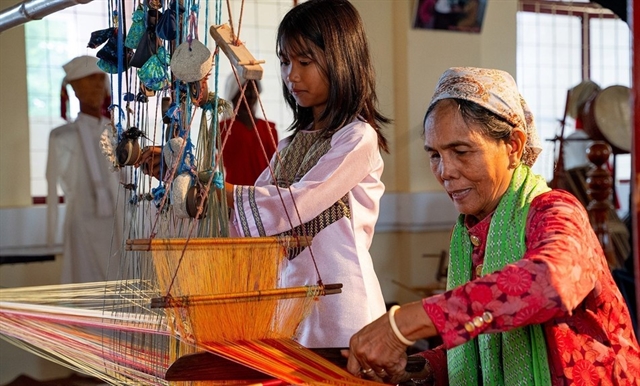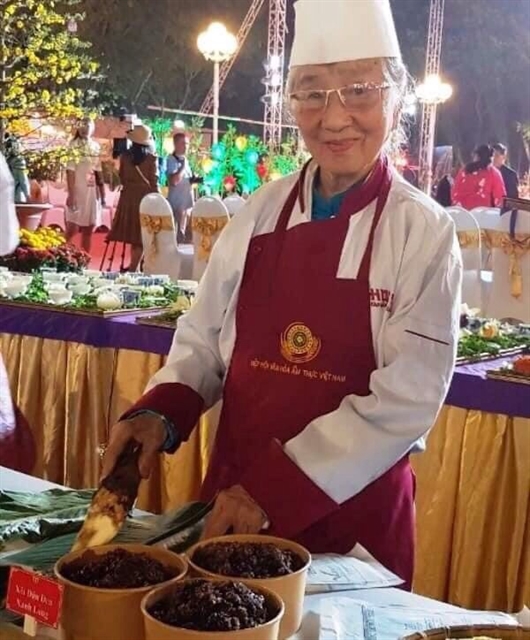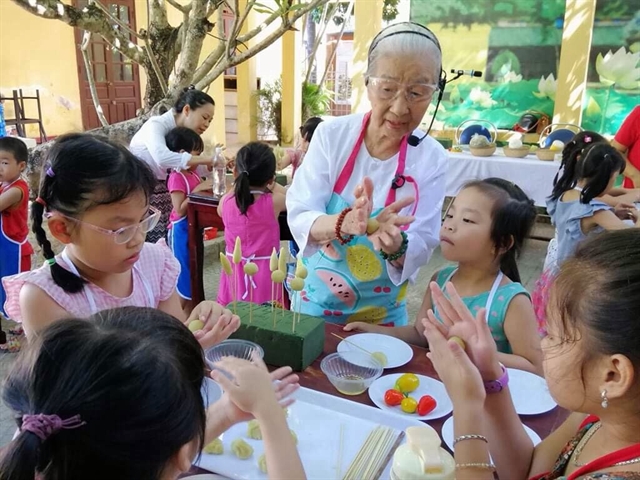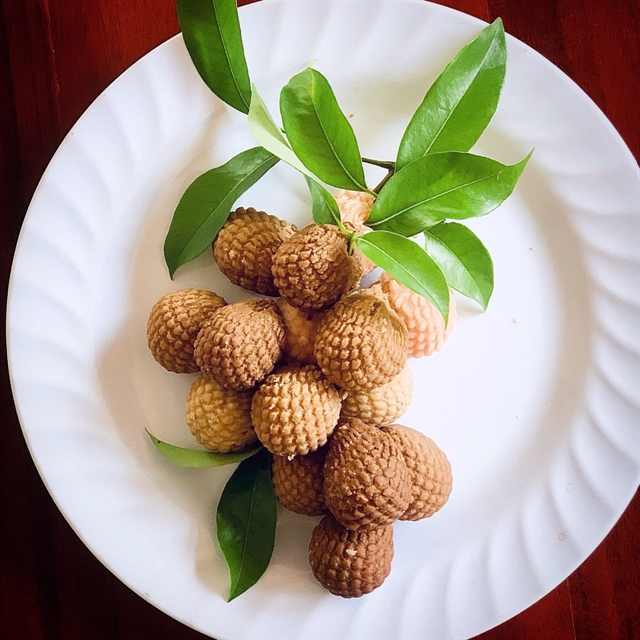 Features
Features

Huế – based culinary artisan Mai Thị Trà has eaten a strict vegetarian diet since the historic flooding which left hundreds dead in the city in 1999.
Minh Nguyễn
Huế-based celebrated cook Mai Thị Trà has eaten a strict vegetarian diet since the historic flooding which left hundreds dead in the city in 1999.
Prior to the flooding, she ate veggie food for only two to 10 days a month as part of her Buddhism. However, after the flooding, she went to help the monks at a nearby pagoda prepare vegetarian food for needy people, which inspired her to switch to a fully vegetarian diet and devote herself to mastering cooking local veggie delicacies.
Before that, she was known for her skill in making traditional Huế cuisine. Born to a noble family where her aunt, Mai Thị Vàng, was a wife of King Duy Tân and her father the district’s top mandarin, Trà was exposed to cooking from a young age.

|
| DEDICATION: Trà cooks at a national culinary event. Photo courtesy of Mai Thị Trà |
“I learned cooking from my mum and other female relatives,” said the master cook, adding that the family often gathered on special occasions such as Tết (Lunar New Year) and cooked up a storm.
She now knows the secrets of making plenty of plant-based dishes thanks to helping cook in pagodas, studying for many decades and of course what she learned from her family.
She is also the author of the bilingual Vietnamese-French book Món chay phong cách Huế -- Vegetariens a la Mode de Hue (Vegetarian dishes in Huế style).
Long-standing tradition
According to Trà, vegetarian cuisine is an important part of Huế gastronomy. The former imperial capital has approximately 200 plant-based dishes and was among the first places in Việt Nam where vegetarianism started.
Huế vegetarianism consists of two styles: royal and monastic.

|
| PASSING ON PASSION: Trà instructs children how to make vegetarian treats at a summer camp. Photo courtesy of Mai Thị Trà |
The royal style originated from a tradition of the king in the past, which started in 1807. Every three years, the king held an offering ritual called Nam Giao Esplanade for which he went vegan and slept at the fasting palace before the ritual began.
The cooks worked hard to create healthy vegetarian dishes for the king. The royal plant-based meals were sophisticated and carefully prepared from vegetables, fruits, legumes and mushrooms imported from China, all cooked in various ways from stewed to grilled.
On the other hand, the monastic style which started in Buddhist pagodas was much more rustic. The monks cooked their meals from simple local ingredients such as squash, legumes, peanuts, sesame and soybean sauce. They didn’t apply fancy cooking techniques nor did they use seasoning due to its scarcity. This way of cooking was popular since it was affordable and easy to follow. Buddhist followers are often on veggie diet on the first and 15th days of a lunar month, which is still practised nowadays. Some became fully vegan or vegetarian like Trà.
In the 20th century, some of the royal members became nuns and introduced the sophistication of the court vegetarian cuisine to a broader community.
The two styles have since blended into each other, creating a diversity of Huế vegetarian dishes.
Celebrating natural flavours
“Huế vegetarian cuisine is all about celebrating the freshness and goodness of plants," Trà said.
Prioritising the natural flavour of plants in cooking, she uses fresh and in-season ingredients. The ingredients are simple but nutrient-rich, ranging from beans and tofu to greens and nuts. While tofu and legumes provide protein, grains – carbs and nuts – fat, greens and fruits are a great source of essential vitamins and minerals.

|
| BEAUTY OF NATURE: Vegetarian version of bánh lá vải made from mung beans, tapioca flour and coconut meat. Photo courtesy of Mai Thị Trà |
The master cook said the healthiest way to cook plant-based dishes involves eating them raw to preserve the goodness and nutrients of the ingredients.
However, whatever way the dishes are cooked, seasoning is crucial.
According to Trà, people often forget how sweet vegetables are and use too many artificial additives. She replaces those sweeteners with natural spices and adds some small cubes of rock sugar to downplay the saltiness and bring a balanced taste to her dishes.
She mentioned that the chefs shouldn’t peel the ingredients too thickly, especially root vegetables, as most of their nutrients lay underneath the skin.
Vegetable broth is the base of Trà’s cooking and used in various dishes like porridge and soup. She stews different kinds of plants like carrots, pumpkins, sweet potatoes and jicama to create flavour layers for the broth.
One of her famous recipes is a mixed soup made from fresh mushrooms, green beans, lotus seeds, potatoes, carrot, tofu skin and vegetable broth. The vegetables are smashed carefully, while lotus seeds are separately boiled and equally divided in different bowls. After seasoning, the final product is an edible art with a pleasant fragrance of beans, a nutty taste of lotus seeds and a sweet flavour of mushrooms.
That was the dish master chef Trà made at the welcome party for the diplomatic corps during the Huế Cultural Week in Hà Nội in 2000. Its strong impression on diners brought her an opportunity to travel to Belgium to introduce Vietnamese vegetarian cuisine to the world.
Cooking from the heart
Cooking vegetarian dishes requires lots of effort and meticulousness from chefs. Therefore, dedication is a prerequisite as this work is “an act of love” in Trà’s words.
Following that philosophy, Trà has diligently practised and created various vegetarian recipes, ranging from soups and noodle dishes to cakes. With experience and creativity, she has delicately changed savoury dishes to plant-based ones by substituting meat ingredients with vegetarian ones, making flavoursome and elegantly plated food.
At the age of 85, master chef Trà still enthusiastically presents and teaches how to cook veggie meals to kitchen lovers at different events and competitions.
She has been working on writing books about traditional vegetarian dishes and cakes of Huế to spread the local culinary art and foster the love for cooking to more people. VNS

|
| EDIBLE ART: Trà's bánh trái vải (lychee cake) looks like the real fruit. Photo courtesy of Mai Thị Trà |

.jpg)


